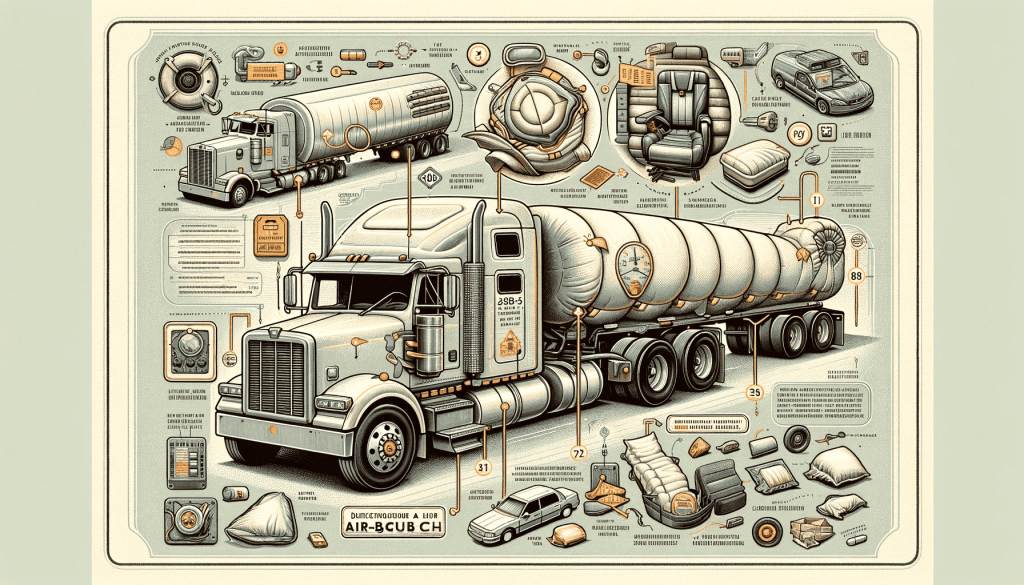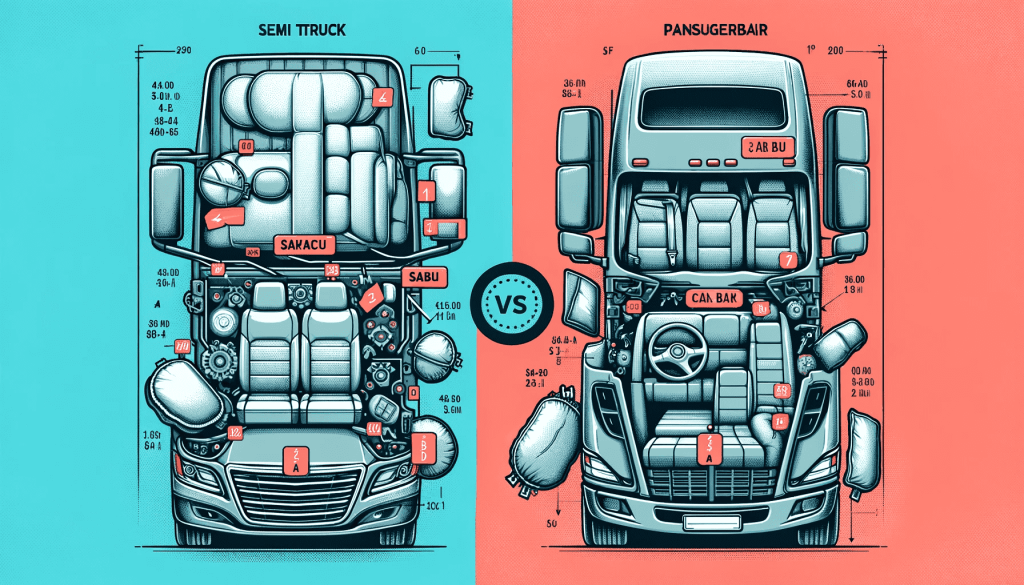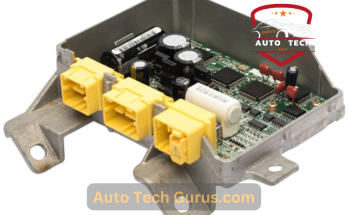Airbags in the World of Semi Trucks
Do Semi Trucks Have Airbags? Picture this: Semi-trucks, those colossal kings of the road, are like the diligent workhorses of our transportation and logistics universe. Day in and day out, they crisscross the country, carrying everything from apples to zippers. But here’s a thought that often tickles the minds of road safety enthusiasts: Do these mammoth vehicles come equipped with airbags, much like their smaller cousins, the passenger cars?
In this blog, we’re diving deep into the fascinating world of semi-trucks. It’s a journey through the nuts and bolts of these commercial giants, zooming in on one critical aspect—airbags. Yes, those life-saving cushions we often take for granted in our cars.
We’ll explore the presence of airbags in semi-trucks, which is more complex than in a family sedan. Think of it as peeling back the layers of an onion, each revealing something more about these behemoths and their safety features.
Our exploration will take us through the evolution of airbag technology—how it’s been tailored and tweaked to fit the unique challenges of driving something as massive as a semi-truck. It’s not just about cushioning the driver in an accident; it’s about rethinking safety in a vehicle where the driver sits high above the road, commanding a ship on wheels. After all, when a semi-truck is involved, it’s not just a single vehicle’s safety at stake; it’s about a collective road-sharing harmony.
So buckle up, and let’s embark on this journey of discovery. By the end, you’ll have a newfound appreciation for these road titans and the intricate safety measures that protect us all.
Comprehensive Safety Practices for Semi-Truck Operations
A Detailed Overview
Smart Trip Planning: Imagine you’re setting off on a road trip. You’d check the safest routes, avoiding high-crime areas and traffic jams. That’s what smart trip planning is all about. And don’t forget to check the weather—nobody likes driving in a storm!
Defensive Driving: It’s like playing chess on the road. Always think a few moves ahead. Keep an eye on those blind spots and maintain a safe distance from the car; it’s all about being prepared for the unexpected.
Cargo Security: Think of your cargo as a precious treasure. You’d want it tied down securely. That’s precisely how we should treat anything we’re transporting. Regular vehicle check-ups? Absolutely essential. It’s like going to the doctor but for your car.
Sharing the Road: Have you ever driven near a semi-truck? They’re giants on the road. Pass them quickly but carefully, always on the left. It’s like a dance where both partners must be in sync, especially when the weather turns sour.
Lighting and Stopping: High beams and trucks need to mix better. It’s like accidentally shining a flashlight in someone’s eyes. And always signal early; it gives trucks enough time to react, like providing a heads-up to a friend.
Distraction-Free Driving: Imagine driving is like having a meaningful conversation—you wouldn’t start texting in the middle of it, right? Keeping your eyes on the road is just like that. Stay focused and avoid those unnecessary distractions.
All-Round Safety: It’s not just about driving. It’s about living healthy—good sleep, exercise, and eating right. Think of your car as a spaceship; you’d want to check it thoroughly before and after each mission, right? And always be extra careful in work and school zones; it’s like being a guardian angel for those around you.
Emergency Ready: Always have a plan B, like a superhero. Be predictable on the road; it’s like giving clear signals in a conversation so everyone knows your intentions.
Airbag Savvy: Airbags in trucks are like personal bodyguards, ready to spring into action. Knowing how they work and keeping them in check is crucial. And remember, sitting correctly is critical—it’s like finding the sweet spot in a comfy chair.
Tech and Law Up-to-Date: Staying updated with airbag technology is like keeping up with the latest smartphone updates. And legal compliance? It’s like following the rules of a game—it keeps everyone safe and the game fair.
Safety Features in Semi Trucks
Various safety features commonly found in semi trucks
In the realm of semi trucks, it’s observed that airbag systems are less commonly found than in passenger cars. However, when installed, they are specifically designed to provide protection during frontal collisions. Typically, these airbags are strategically placed in the steering wheel or dashboard, primarily for the driver’s safety.
Furthermore, significant attention is given to advanced braking systems. Integrated systems like ABS and EBD improve braking performance. These systems are essential for maintaining control during sudden stops and are instrumental in reducing the risk of jackknifing.

Additionally, Electronic Stability Control (ESC) plays a pivotal role. This feature detects and minimizes traction loss, which is crucial in preventing rollovers and maintaining control under challenging conditions.
Moreover, due to their considerable size, semi trucks are equipped with Blind Spot Monitoring systems. These systems utilize sensors to alert drivers of vehicles in those hard-to-see areas, thereby enhancing safety during lane changes.
Also, Lane Departure Warning Systems are implemented. These systems trigger alerts when the truck drifts out of its lane without signaling, preventing accidents caused by inattention or drowsiness.
Furthermore, Collision Avoidance Systems are increasingly being used. Employing radar and sometimes cameras, these systems can detect potential collisions, issue warnings, and, in some instances, automatically apply brakes to prevent or lessen the impact of a crash.
In addition, to tackle limited rear visibility, rearview cameras are installed. These cameras provide a clear view of the area behind the truck, proving invaluable for reversing maneuvers.
Equally important are Tire Pressure Monitoring Systems. These systems continuously monitor the pressure in each tire, alerting the driver to any irregularities, which is critical to preventing blowouts and maintaining overall vehicular safety.
Moreover, systems that monitor driver alertness are also incorporated. These systems detect signs of fatigue or inattention, issuing alerts to encourage taking breaks or resting.
Additionally, Roll Stability Control is a noteworthy feature. This system prevents rollovers by detecting and managing skidding or fishtailing, especially during turns or sudden maneuvers.
Furthermore, in the event of a fire, Fire Suppression Systems are crucial. These systems automatically detect and extinguish fires in critical areas like the engine compartment, averting more enormous catastrophes.
Also, Escape Hatches or Roof Hatches are included as alternative escape routes in emergencies, such as rollovers.
Lastly, the truck’s visibility is enhanced by high-visibility reflective tape and improved lighting, which is particularly beneficial in low-light conditions.
In conclusion, while airbags may not be as prevalent in semi trucks as in passenger vehicles, many other safety features are employed. These features contribute significantly to the safety of both the truck driver and other road users, ensuring a safer driving environment for everyone involved.
The Evolution of Semi Truck Safety
Tracing the Journey to Modern Airbag Systems
Imagine a time when semi-trucks, those giants of the highways, roamed the roads without the advanced safety features we see today. It’s a bit like thinking of old movies—classic but not quite equipped for modern expectations. This was the reality for semi trucks not too long ago. They lacked many of the safety innovations that were becoming standard in passenger cars. But, just like any great story, things began to change.
Let’s zoom in on airbags, a real game-changer in truck safety. In the beginning, finding an airbag in a semi-truck was as rare as finding a needle in a haystack. But as the pages of time turned, so did the industry’s approach to safety. With advancements in technology and a growing emphasis on protecting lives, airbags started making their grand entrance into the world of semi trucks, focusing on shielding drivers during frontal impacts.
But the story doesn’t end there. Like a tree branching out, other safety features grew and evolved. Braking systems, for instance, got a major upgrade. ABS and EBD came into the picture, transforming trucks into more stable and controllable beasts, especially during those heart-stopping moments of abrupt braking.
Then there’s the tale of stability control systems. Once a feature you’d only see in luxury cars, it became a standard ally in the fight against truck rollovers. It’s like having an invisible guardian angel keep the truck steady and upright.
Blind spot monitoring and lane departure warnings also joined the safety crew. Initially exclusive to high-end cars, these features found a new home in semi trucks, tackling the unique challenges of maneuvering these massive vehicles.
And let’s remember collision avoidance systems. What once sounded like science fiction trucks that could sense and avoid crashes is now a reality, thanks to cutting-edge sensors and algorithms.
The digital revolution also made its mark. Driver alertness monitoring and advanced tire pressure monitoring systems started playing crucial roles in preventing accidents before they happened. It’s like having a smart co-pilot, always on the lookout for potential dangers.
Moreover, the introduction of rearview cameras and enhanced lighting tackled one of the biggies in truck driving: visibility. It’s like giving trucks a pair of high-tech glasses, making everything clearer and safer.
In wrapping up this journey, it’s clear that the evolution of safety features in semi trucks, especially airbags, is a testament to the industry’s commitment to road safety. These advancements and the development of other safety technologies have been pivotal in steering semi trucks toward a safer future for drivers and everyone who shares the road with these highway giants.
Airbag Systems in Semi Trucks
Detailed Examination Of Airbag Systems In Semi Trucks
Let me tell you about the airbag systems in semi-trucks. Now, these things are super important for keeping drivers safe, especially if there’s a crash. They’re more complicated than the airbags in your car, mainly because semi trucks are so much bigger and handle differently.
First, let’s chat about why these systems differ for semi trucks. You see, these big rigs have a higher centre of gravity and need more room to stop. That means they need airbags that can handle these differences. The main idea here is to keep the driver safe from harm, which is a big deal considering how massive these trucks are.
So, what’s in these airbag systems? Well, the most noticeable part is the airbag itself. It’s made from this brutal, flexible fabric that pops open fast during a crash to protect the driver. Then, there are sensors that figure out how bad the crash is and tell the airbag when to inflate. These little guys are super important.
There’s also this control unit—think of it as the brain of the operation. It takes the information from the sensors and decides if it’s time to deploy the airbag. It’s got to make the right call because setting off the airbag at the wrong time can be just as bad as not having it go off at all.
Now, keeping these systems in tip-top shape is a big deal. Regular checks ensure everything—the sensors, control unit, and airbags—works correctly. It isn’t just about following rules; it’s about keeping everyone on the road safe. If something’s off with the airbag system, it could lead to bad situations.
To summarise, semi-truck airbag systems are crucial for driver safety. They’re specially designed for the unique challenges these big vehicles face. And with technology getting better all the time, we’re likely to see even more relaxed and effective systems in the future. It’s all about ensuring our truck-driving friends are as safe as possible on the road.
How Airbag systems work and their Effectiveness
Airbag systems in semi trucks operate through a well-coordinated process designed to offer maximum protection during a collision. This process starts with sensors strategically placed throughout the car to detect a sudden impact or a rapid deceleration. These sensors are sensitive and accurately gauge the severity of a collision. They immediately send signals to the airbag control unit upon seeing an effect.
The control unit processes these signals as the system’s brain. It rapidly assesses the data to determine if the situation warrants airbag deployment. This decision is made within milliseconds, a crucial factor given the fast-paced nature of road incidents. If the control unit decides to deploy the airbags, it activates the inflator mechanism.
The inflator mechanism is a critical component. It generates a gas that rapidly fills the airbag, causing it to expand. This expansion happens in the blink of an eye, ensuring that the airbag is fully inflated when the driver comes into contact with it. The airbag, made of a durable, lightweight fabric, then acts as a cushion, reducing the impact force on the driver.
The effectiveness of airbag systems in semi trucks is significant. Studies and real-world data consistently show that airbags substantially reduce the risk of severe accident injuries. Drivers in trucks equipped with airbags are less likely to suffer from head and upper body injuries, which are common in high-impact collisions. The cushioning effect of the airbag can be the difference between minor and life-threatening injuries.
However, it’s important to note that airbags are most effective when used with seat belts. Seat belts keep the driver in the correct position during a collision, ensuring that the airbag can provide optimal protection. Without a seat belt, the driver might be thrown into an unfavorable position, diminishing the airbag’s effectiveness.
Airbag systems in semi trucks work through a swift and precise process, starting from impact detection to the total inflation of the airbag. Their effectiveness in reducing the severity of injuries is well documented, making them an indispensable safety feature in modern trucking. The synergy of airbags and seat belts offers a robust protective mechanism, underscoring the importance of comprehensive safety practices in the trucking industry.
Comparison with Passenger Vehicles
The Differences Between Semi Trucks and Standard Cars
When contrasting the airbag systems in semi trucks with those in standard cars, several vital differences emerge, primarily due to these vehicles’ distinct nature and requirements.
Firstly, the size and structure of the airbags differ significantly. In semi trucks, airbags are generally larger and more robust, reflecting the larger cabin space and the need to protect the driver who sits higher off the ground. It contrasts with standard cars with smaller airbags designed for a more compact space.

Secondly, the placement and number of airbags vary. Standard cars often feature multiple airbags, including side, front, and knee airbags, to protect passengers in various collisions. On the other hand, semi-trucks primarily focus on frontal airbags due to the driver’s solitary position and the nature of most truck collisions.
The triggering mechanism of airbags in semi trucks is also more complex. Given the heavier weight and longer stopping distances of semi trucks, their airbag systems need to be calibrated differently. They often require more sensitive sensors to detect the impact that should trigger airbag deployment accurately. In contrast, standard cars, being lighter and more agile, have airbag systems designed for quicker responses to a broader range of collision types.
Additionally, the maintenance and inspection protocols for airbag systems in semi trucks are usually more rigorous. Due to the increased wear and tear trucks undergo, they necessitate frequent checks to ensure safety mechanisms remain operational. While regular maintenance is still essential for standard cars, the frequency and extent of checks tend to be less demanding.
Finally, the role of airbags in the overall safety strategy varies between the two. In standard cars, airbags are part of a comprehensive safety system that includes advanced features like crash avoidance technology and pedestrian detection systems. In semi trucks, while airbags are crucial, the emphasis is often more on preventing accidents through stability control and advanced braking systems, given the more significant consequences of truck accidents.
Although the primary purpose of airbag systems in both semi-trucks and standard cars is to protect occupants in case of a collision, their design, functionality, and maintenance requirements are significantly different. These differences reflect the distinct operational environments, vehicle dynamics, and safety challenges associated with each type of vehicle.
Insights Into Design Differences and Safety Impacts
The design differences in airbag systems between semi trucks and standard cars directly impact their safety effectiveness, addressing the specific challenges of each vehicle type. Due to their larger size and mass, semi-trucks require more extensive and robust airbags. These airbags must withstand the force of high-impact collisions typical in truck accidents. In contrast, airbags in standard cars are smaller and designed for rapid deployment in various collision scenarios, including side and rear impacts.
The sensitivity of the airbag sensors also varies markedly. In semi trucks, the sensors are calibrated to detect and respond to the impacts most common in trucking accidents, like rollovers or front-end collisions. It differs from cars, where sensors are fine-tuned to a broader range of collision types, including those at lower speeds.
These design nuances have a significant effect on safety. In semi trucks, the sturdy and expansive airbags are essential for protecting the driver in severe crashes. They offer a larger cushioning area, compensating for the driver’s elevated position and more significant potential for movement during a collision. For standard cars, strategically placed and swiftly deploying airbags are crucial for safeguarding occupants from injuries at multiple collision angles.
Maintenance practices also contribute to the safety impact. Semi-trucks, often operating under harsher conditions, demand rigorous airbag system maintenance. It ensures their readiness in critical situations. Cars can maintain optimal airbag functionality with less frequent checks.
In summary, the tailored designs of airbag systems in semi-trucks and standard cars reflect their distinct operational needs and safety challenges. While both aim to protect occupants, the specific design choices and maintenance regimes are crucial for their effectiveness in enhancing safety across different vehicle types.
The Importance of Airbags in Semi Trucks
Why Airbags are crucial for semi-truck safety
Airbags play a crucial role in semi-truck safety, primarily due to the unique risks of operating these large vehicles. Firstly, the size and weight of semi-trucks make collisions potentially more severe. In such scenarios, airbags provide a vital cushioning effect, significantly reducing the impact force on the driver.
This cushioning is especially important given the height at which truck drivers are seated, making them more vulnerable to upper-body and head injuries during accidents.
Long-haul trucking involves driving for extended periods of time. Driver fatigue can be a major factor in accidents, and certain activities or behaviours can increase the likelihood of experiencing driver fatigue and, therefore, the risk of accidents.
Airbags can be a crucial safety feature in such situations, protecting the driver in a collision. Rapid deployment of airbags in a crash can be the difference between life-threatening and more manageable injuries.
Additionally, the high center of gravity in semi-trucks makes them more susceptible to rollover accidents. Airbags in these vehicles are designed to deploy in rollover scenarios, providing essential protection to the driver. This aspect of airbag functionality is crucial in mitigating the risk of severe injuries in rollover accidents, which are among the most dangerous for truck drivers.
Furthermore, the presence of airbags also enhances overall safety consciousness. Knowing that their vehicle has this essential safety feature can encourage drivers to adhere to safety protocols and drive more cautiously, contributing to a safer driving environment.
In conclusion, airbags are indispensable for semi-truck safety due to their ability to lessen the impact of collisions, protect against injuries in rollover accidents, and foster a culture of safety among drivers. Their role in safeguarding truck drivers must be balanced, as they provide a critical line of defense in mitigating the risks inherent in operating such large vehicles.
Real-life statistics or case studies showcasing their impact.
Airbags in semi-trucks have significantly impacted safety, as various studies and real-life cases have shown. According to the National Highway Traffic Safety Administration (NHTSA) in the United States, using airbags in heavy trucks can significantly reduce the number of fatalities and serious injuries caused by frontal collisions. Their studies have shown that the risk of death is reduced when airbags are used with seat belts.
In addition to broad studies, individual case studies have demonstrated the life-saving effects of airbags in semi-trucks. These documented incidents often compare the outcomes of accidents involving trucks with and without airbag systems. The stark differences show a clear benefit regarding reduced injuries and fatalities when airbags are present.
Insurance companies have also contributed to this understanding through their analysis of claims. They have noted a marked decrease in the severity of injuries in accidents where airbags were deployed in semi-trucks. It reflects the safety benefits for drivers and points to reduced financial costs associated with these accidents.
Driver testimonials provide a more personal perspective. Truck drivers who have been in accidents with and without airbags consistently report how airbags helped them survive or avoid serious injuries. These real-life experiences underscore the practical value of airbags in protecting drivers during high-impact collisions.
Comparisons with passenger vehicles further reinforce the importance of airbags. Studies comparing the efficacy of airbags across different vehicle types show that, while the dynamics may vary, the role of airbags in preventing severe injuries remains significant in both semi-trucks and passenger cars.
Overall, these statistics and real-life examples paint a clear picture: airbags are a crucial safety feature in semi-trucks, significantly enhancing driver safety and reducing the overall impact of road accidents.
Regulatory Standards and Future Trends
Understanding the Latest Airbag Regulations for Semi Trucks
As of 2024, there are no legal requirements for airbags in semi-trucks, which contrasts with the regulations for passenger vehicles. This difference stems from the unique characteristics of semi-trucks. Their larger mass and slower deceleration during collisions result in different force dynamics within the cab compared to smaller vehicles. Consequently, as perceived by regulatory bodies, the necessity for airbags in semi-trucks is less pronounced than in passenger cars.
Despite this absence of mandatory regulations, many semi-truck manufacturers have proactively included airbags in their vehicles, prioritizing driver safety. Volvo, a pioneer in this area, has equipped its trucks with driver-side airbags since the mid-1990s. Similarly, Freightliner introduced specialized airbags designed for rollover protection.
Other major manufacturers like Peterbilt, Kenworth, International, Mack, and Western Star have also adopted airbag systems, mainly focusing on rollover protection through systems like Rolltek.
These initiatives by manufacturers highlight a commitment to enhancing safety beyond regulatory demands. They recognize that, while not legally required, airbags can play a significant role in reducing injury severity during accidents.
Alongside airbags, semi-trucks also incorporate other safety technologies like seat belts, electronic stability control, collision mitigation systems, lane departure warnings, and blind spot detection, all of which contribute to a comprehensive safety approach for these large vehicles.
Upcoming Changes In Safety Technology
In 2024, the semi-truck industry will experience significant advancements in safety technology. One notable trend is predictive maintenance, which uses data and technology within vehicles to anticipate maintenance needs. This approach revolutionizes truck maintenance by preventing catastrophic failures and reducing downtime and repair costs. It represents a significant shift in maintaining fleet health and efficiency.

Another critical development is the rise of green trucking. This trend aims to minimize the negative impact on the environment. Trucking operations utilize alternative fuels, electric trucks, and renewable energy sources. Green trucking cuts down greenhouse gas emissions and fuel costs and contributes to better air quality and public health. It marks a critical step towards a more sustainable future in the trucking industry.
Trucking analytics is also gaining momentum, propelled by artificial intelligence and machine learning technologies. These tools optimize routes, analyze driver behavior, and enhance fleet performance. Implementing tracking analytics leads to more intelligent decision-making, increased efficiency, and improved road safety.
Moreover, advancements in fleet management are streamlining operations. Integrating IoT and cloud computing in fleet management systems allows for real-time tracking and predictive analytics, leading to better resource allocation and maintenance scheduling. This development is critical to optimizing asset utilization and improving fleets’ operational efficiency.
These emerging trends and technologies reflect the trucking industry’s ongoing commitment to improving efficiency, sustainability, and safety. They signify a proactive approach to embracing technological advancements for a safer and more environmentally responsible future in trucking.
Factors Influencing The Absence Of Airbags In Semi Trucks
Several factors contribute to the absence of airbags in semi trucks:
- Vehicle Design: Semi trucks are designed differently from passenger vehicles. They are typically larger and heavier, with a different cabin layout. The design of these trucks often needs to accommodate the use of traditional airbag systems found in smaller vehicles.
- Safety Regulations: As of my last update in January 2022, there were no regulations mandating the installation of airbags in semi-trucks. Safety regulations for commercial vehicles often focus on other aspects, such as braking systems, lighting, and load securing.
- Cost Considerations: Implementing airbag systems in semi trucks would involve significant research, development, and installation costs. Given their size and weight, the cost-benefit analysis might not favor the inclusion of airbags, especially when other safety features are prioritized.
- Effectiveness: The effectiveness of airbags in semi-trucks may be questioned due to the different dynamics of accidents involving these large vehicles. The impact of an airbag in a collision involving a semi-truck might not provide the same level of protection as it does in a passenger vehicle.
- Driver Position: In many semi trucks, the driver sits higher up and farther away from the steering wheel compared to most passenger vehicles. This difference in seating position could affect the effectiveness and deployment of airbags.
- Driver Training and Behavior: Safety in semi trucks often relies heavily on driver training, experience, and adherence to safety protocols. Emphasis is placed on defensive driving, proper handling of the vehicle, and maintaining safe distances from other cars to prevent accidents.
- Alternative Safety Measures: Semi trucks incorporate other safety features such as reinforced cabins, seat belts, anti-lock braking systems (ABS), stability control systems, and collision avoidance systems to mitigate the risks of accidents.
While airbags may not be standard in semi trucks, ongoing research and advancements in vehicle safety could lead to changes in the future. However, any implementation needs to address the unique challenges and requirements of these commercial vehicles.
FAQ’s
1. What semi trucks have airbags?
Large semi-truck manufacturers like Volvo, Freightliner, Peterbilt, and Mack have installed airbags in some trucks. However, not all models come equipped with them. Most of these trucks feature the Rolltek airbag system by IMMI, which provides added protection for the driver.
2. Do heavy-duty trucks have airbags?
While not all heavy-duty trucks have airbags, many newer models do. Manufacturers are increasingly incorporating airbag systems for improved driver safety. Including airbags, especially in more recent models, reflects an industry-wide shift towards enhanced safety features.
3. Why do lorries not have airbags?
Historically, lorries (or heavy trucks) were not fitted with airbags because their larger mass and slower deceleration during a collision were thought to reduce the force experienced inside the cab, thereby lessening the need for airbags. Additionally, airbag requirements set by legislation primarily targeted passenger vehicles, not heavy trucks. However, this trend is changing as more manufacturers recognize the safety benefits of airbags in lorries.
4. What is air-to-air on a semi?
“Air to air” on a semi refers to an air-to-air aftercooler (ATAAC) system. This system cools the turbocharger’s compressed air before entering the engine’s intake manifold. Cooling the air increases density, allowing for more efficient combustion and improved engine performance.
5. Do Scania trucks have airbags?
Scania, known for its emphasis on safety, has incorporated airbags in many of its truck models. As a leading manufacturer in the trucking industry, Scania continually integrates advanced safety features, including airbags, to enhance driver protection.
6. Which semi-truck is the safest?
Determining the “safest” semi-truck can vary based on criteria such as safety features, crash test ratings, and driver feedback. However, brands like Volvo, Peterbilt, and Mack are often recognized for their commitment to safety. Volvo, in particular, is renowned for pioneering safety features in the trucking industry. The safest semi-truck typically includes advanced safety technologies, robust build quality, and a strong focus on driver protection systems.



